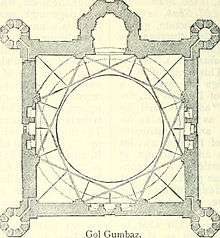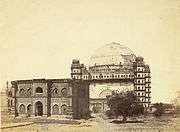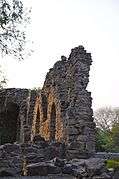Gol Gumbaz
Gol Gumbaz is the mausoleum of Mohammed Adil Shah, Sultan of Bijapur. The tomb, located in Bijapur, Karnataka in India, was completed in 1656 by the architect Yaqut of Dabul. The name finds its roots from Gola gummata deriving from Gol Gombadh meaning "circular dome".[1] It is constructed as per the Deccan architecture".[2]
Architecture

Plan of Gol Gumbaz
The structure is composed of a cube, 47.5 metres (156 ft) on each side, capped by a dome 44 m (144 ft) in external diameter. "Eight intersecting arches created by two rotated squares that create interlocking pendentives" support the
dome. At each of the four corners of the cube, is a dome-capped octagonal tower seven stories high with a staircase inside.[2] The upper floor of each opens on to a round gallery which surrounds the dome. Inside the mausoleum hall, is a square podium with steps on each side. In the middle of the podium, a cenotaph slab on the ground marks the actual grave below, "the only instance of this practice" in the architecture of the Adil Shahi Dynasty. In the middle of the north side, "a large semi-octagonal bay" protrudes out.[2] With an area of 1,700 m2 (18,000 sq ft),[3] the mausoleum has one of the biggest single chamber spaces in the world. Running around the inside of the dome is the "Whispering Gallery" where even the softest sound can be heard on the other side of the mausoleum due to the acoustics of the space.[3]
Gallery
| Dome with intersecting arches from the inside |
| Gol Gumbaz - view from the entrance. |
| One of the minars as viewed from the terrace. |
| Historical Cannon displayed in front of Golgumbaz |
|
References
External links
 |
Wikimedia Commons has media related to Gol Gumbaz. |
Coordinates: 16°49′48″N 75°44′9″E / 16.83000°N 75.73583°E / 16.83000; 75.73583
|
|---|
|
| Overviews | |
|---|
|
| History | |
|---|
|
| Geography | |
|---|
|
| Culture | |
|---|
|
| Literature | |
|---|
|
| Noted poets | |
|---|
|
| People and Society | |
|---|
|
| Tourism |
- Beaches
- Dams
- Forts
- National Parks
- Hindu Temples
- Jain Temples
- Waterfalls
|
|---|
|
| Awards | |
|---|








